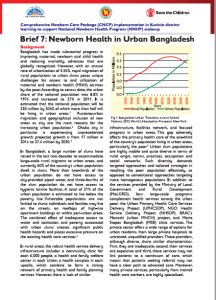
Bangladesh has made substantial progress in improving maternal, newborn and child health and reducing mortality, advances that are globally recognized. However, with an annual rate of urbanization of 3.55% rapid migration of rural populations to urban slums poses unique challenges for access to and utilization of maternal and newborn health (MNH) services by the poor.
Bangladesh has already attained the Millennium Development Goal for child mortality. While the under-5 and infant deaths have been drastically reduced, the neonatal mortality rate has reduced more slowly, from about 52 deaths per 1,000 births in the early 1990s to 28 per 1,000 for the mid-2010s. Most neonatal deaths occur within the first week of life. In Bangladesh, the major causes are complications of prematurity, infections, and intrapartum complications like birth asphyxia.
The Urban Health Survey (UHS) 2013 looked at three major domains of urban areas: slum populations and non-slum populations residing in nine city corporations, and the rest of the urban population, including district municipalities and large towns or pourasavas with more than 45,000 residents (according to the 2011 population census).
—
This is Brief 7 in a series. The other briefs are:
Brief 1: National Newborn Health Program (NNHP) for Ending Preventable Newborn Deaths in Bangladesh
Brief 2: Implementing outpatient management of infections in young infants: Building the skills of union level providers
Brief 3: Facility Readiness and Initiation of Kangaroo Mother Care
Brief 4: Improving newborn care and care-seeking practices in Bangladesh through an SBCC approach
Brief 5: Newborn Commodities in Bangladesh Health System
Brief 6: Implementing the Comprehensive Newborn Care Package: Integration and Use of Data in Routine Health Information System